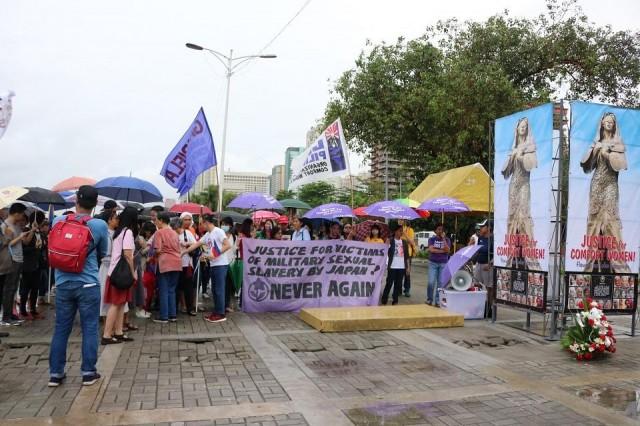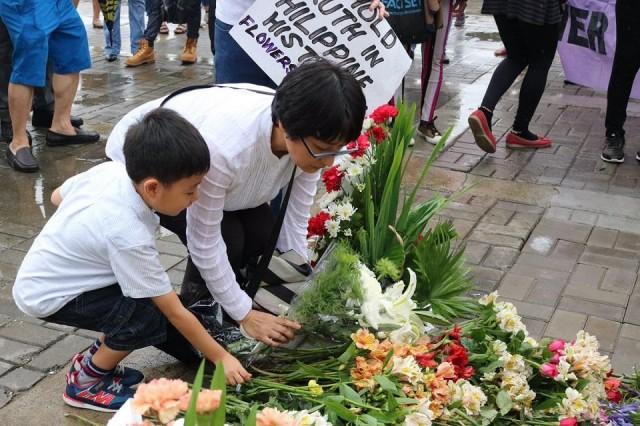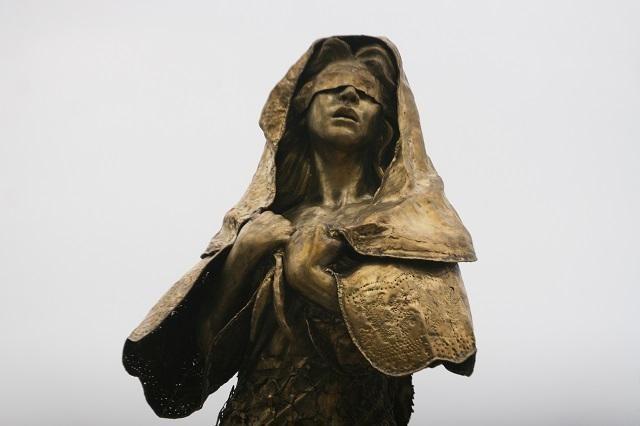Day of collective shame: When the comfort woman statue was removed

27 April 2018 is a date that should live in our collective shame. That night, personnel in orange uniforms reportedly removed a monument to comfort women from Roxas Boulevard and demolished its base.
Days before that, a concerned citizen messaged me that he was worried about a backhoe parked beside the monument, which was erected on 8 December 2017 by Chinese-Filipino organization Tulay Foundation with an accompanying memorial marker provided by the National Historical Commission of the Philippines.
The Japanese Embassy aired its concern to our government about the statue. But I thought that it was covered by the National Cultural Heritage Act of 2009, and that the government would not consent to such a brazen thing as removing it. This would actually court more national attention to the statue, and besides, it represented the Filipino perspective of history which they ought to defend. Nevertheless, I messaged some authorities about it.
But they still did it, in the middle of the night, without any announcement. People slowly realized that the statue was no longer there the next day. Disbelief turned to anger as concerned citizens confirmed through photographs that the statue is now gone.
Subsequently the City Government of Manila said they removed the statue to conduct a drainage improvement project in the area. They returned the statue to the sculptor, Jonas Roces.
That afternoon, I joined a hurriedly prepared press conference hosted by Melo Acuña with co-panelists Teresita Ang See of Kaisa para sa Kaunlaran, Representative Emmi de Jesus of Gabriela, and Sharon Cabusao, coordinator of the Women’s Political Rights Program of Gabriela to denounce this act.
"Ang nangyari, lumuhod tayo sa mga Hapon," said Ang See.
"Wala ni isang bansa ang lumuhod sa kanila. Not Sydney, not Seoul, not San Francisco, not Seattle, not Germany; wala sa kanila ang nag-give in sa pressure ng Japan, except tayong Pilipinas kaya nakakahiya. Nakakahiya."
I declared, "Nananawagan kami sa lahat na ipaglaban natin na maibalik ang estatuwang ito, magmalasakit po tayo sa monumentong ito, dahil hindi lamang poi to bato, hindi lamang poi to semento, dangal po ng bayan natin ito."
A few days later, 29 April, President Rodrigo Duterte said that although he did not have a hand in the removal, he favored it.
"That issue so far as I’m concerned tapos na 'yan," he said. "The Japanese had paid dearly for that. Although unintended, the wounds of the past continue to hurt sensibilities. Some might use this issue to hurt Japan, and Japan might be suspicious that the Chinese are using this issue. But take away the Chinese and the Japanese in the equation, it should be a remembrance to Filipinos of a time when we were weak. The controversy reminds us that the past lingers and it is important that it lingers. We move on, but we remind ourselves never again to war, and that we should make ourselves strong.
"'Yung reparations started many years ago. So huwag na lang natin insultuhin. But if there is what you would call a memorial for an injustice that was committed at that time, it’s all right, but do not use… it is not the policy of the government to antagonize other nations. But if it's erected in a private property, fine, we will honor it, and the Japanese government and people would understand. …Masakit kasi na ulit-ulitin tuloy. I start to imagine how they were treated badly. But Japan has apologized to the Filipinos and they have certainly made much more in terms of reparations."
Duterte was referring, aside from the various aid and loans given to the country by Japan, to a compensation fund set up by the Asian Women’s Fund in 1995 from private donors from Japan.
Above: Professor Xiao Chua and Professor Van Ybiernas talk about the comfort women issue on an episode of Dulowtard History Live
A few days later, 29 April, President Rodrigo Duterte said that although he did not have a hand in the statue's removal, he favored it.
"That issue so far as I’m concerned tapos na 'yan," he said.
"'Yung reparations started many years ago. So huwag na lang natin insultuhin. But if there is what you would call a memorial for an injustice that was committed at that time, it’s all right, but do not use… it is not the policy of the government to antagonize other nations. But if it's erected in a private property, fine, we will honor it, and the Japanese government and people would understand. …Masakit kasi na ulit-ulitin tuloy. I start to imagine how they were treated badly. But Japan has apologized to the Filipinos and they have certainly made much more in terms of reparations."
Duterte was referring, aside from the various aid and loans given to the country by Japan, to a compensation fund set up by the Asian Women’s Fund in 1995 from private donors from Japan.
Independence Day Protest

Teresita Ang See chose 12 June 2018, which turned out to be a rainy Independence Day, to lead a demonstration at the site of the monument. She chose the holiday to demonstrate that removing the statue is like a demonstration of our actual lack of independence.
A tarpaulin bearing the image of the statue was erected where it once stood and I was assigned as master of ceremonies of the event. A campaign started and was called #FlowersForLola. This was the first in a series of commemorative events that happened the rest of the year.
Aside from addresses given by people who had been fighting for years for their cause, Sister Mary John Mananzan and Representative Arlene Brosas of Gabriela, a group of children from conflict areas taken care of by the Children’s Rehabilitation Center, did their bit and sang and offered flowers as well.
Groups who joined the humble event were Kaisa Para sa Kaunlaran, the descendants of the Wa Chi guerillas who fought against the Japanese, Gabriela, Lila Filipina (an organization of comfort women), senior high school students from the Philippine Cutural College, UP Lipunang Pangkasaysayan and Buklod CSSP. Also present was attorney Dennis Gorecho ,who has been following and working for the comfort women case since the nineties.
The event was even made meaningful by the attendance of Naoko Okimoto, a Japanese citizen from Hiroshima, the city where an atomic bomb was dropped during the war, who laid flowers at the site where the monument once stood as a gesture of regret for the actions of some in their government.

A contentious issue
People often confuse "comfort women" with those who were raped and molested once by the Japanese forces during World War 2. But "comfort women" is a term tranlasted from the Japanese "ianfu," a euphemism for prostitutes. Meaning, they were technically sex slaves and were repeatedly abused.
Before the 1990s, not much was known publicly about the comfort women issue. When inquiries were made by the Philippine government on the issue, a war historian used official sources from Japan and the Philippines to say that there was "no major forced prostitution in the Philippines." He cannot be blamed, because the issue did not figure in the war crime trials. Also, these women did not come out immediately because of the shame. To be raped can result in terrible stigma; being sex slaves more so.
In 1992, Lola Rosa Henson came out. Her courage in truth-telling resulted in the documentation of 174 other cases which are now primary sources from those who experienced it. In an interview with Iris C. Gonzales, war historian and UP history professor Ricardo Jose said after further research that "the comfort women issue was raised in South Korea much earlier than us. But the Philippine case is just as serious… Violence against one woman is violence against all women. It’s very frustrating."
Today, right-wing politicians in Japan minimize the issue by saying that these sex workers were not forced, and that the monument is like glorifying prostitution. These were not victims according to this perspective, but people who consented to what happened to them. But forced into the circumstances of war, you really have little choice. Thus, the monument is not a glorification of their sufferings, but more of their strength and truth-telling despite the stigma, beginning in 1992.
Diplomatic complications
Although unintended, the wounds of the past continue to hurt sensibilities. Because Tulay Foundation erected the monument, some suspected that Japan’s traditional antagonist, the government of the China, had something to do with its construction—even though the fact is Tulay Foundation is not a Chinese but a Filipino group. But some still suspect that the monument is part of a proxy war between Japan and China.
Although not all the Japanese want to forget nor erase their war atrocities, many right-wing politicians would like to forget the wounds from the war. Many of their relatives never returned. From their perspective, the Japanese were also victims.
But in all fairness to Filipinos, even if the Japanese soldiers committed atrocities against them, the majority never took it against the Japanese people. President Elpidio Quirino even pardoned the war criminals, even though his wife and three children were killed by the Japanese soldiers during the war.
We even allowed memorial to Japanese war dead around the country, and even a monument to a notorious kamikaze soldier in Mabalacat, Pampanga. The Japanese politicians were over-reacting in wanting to take down this monument—and ideally we should not be affected by it anyway, because this is our country and this is the way we want to remember our past.
Yet, Japan, as according to the New York Times, is our country’s “largest trade partner and the country’s largest aid donor,” providing more than $20 billion in development assistance since the 1960s. So for some in our government, Japan has a say.
And so it was, our government removed the monument, without coordination from the various national cultural agencies.

Implications of the monument and its removal
But take away the China and Japan in the equation. The monument should have been a remembrance to Filipinos of a time when we were weak. The controversy reminds us that the past lingers, and it is important that it lingers. We move on, but we remind ourselves never again to war, and that we should make ourselves strong.
But the statue's removal also demonstrated that we haven’t gone far enough in making ourselves strong. It has shown that we are still a weak country. We were bullied to take down our own monument at the request of a foreign country. We were the only one who did so. What kind of country will have itself dictated to over how it commemorates its own past? That we knelt down to Japan sacrificing national dignity is a reminder to the next generation that hopefully they will create a better, stronger nation so this wouldn't have to happen again.
That the statue had to be taken down unceremoniously like that is like assaulting again the memory of the comfort women. It is as if their suffering hasn't ended.
For the comfort woman monument should have been the fitting reminder. “Laced” beautifully in metal, it shows a blindfolded sex slave. Yet different from other monuments to comfort women which were mostly sitting down or bowed in shame, ours is defiant and struggles to rise, to reclaim her dignity. It is a reminder to Filipinos of the story of Inang Bayang Pilipinas herself. Forced to engage with colonizers and continued foreign intervention, she continues to rise up despite her the odds, as we should rise up, and sing our own song.
If our state failed to protect this one memorial to our perspective of history, it is left to us, the ordinary people, to tell the story of comfort women to younger generations because if the Japanese government cannot give official recognition to the experiences of our lolas, then the only way the comfort women can have justice is when they are remembered. History is the ultimate judge.
Professor Michael Charleston “Xiao” Briones Chua is currently assistant professorial lecturer at the De La Salle University Manila and senior lecturer at the University of the Philippines Diliman. He is a historian and was a consultant for the GMA News TV series “Katipunan” and “Ilustrado.”



